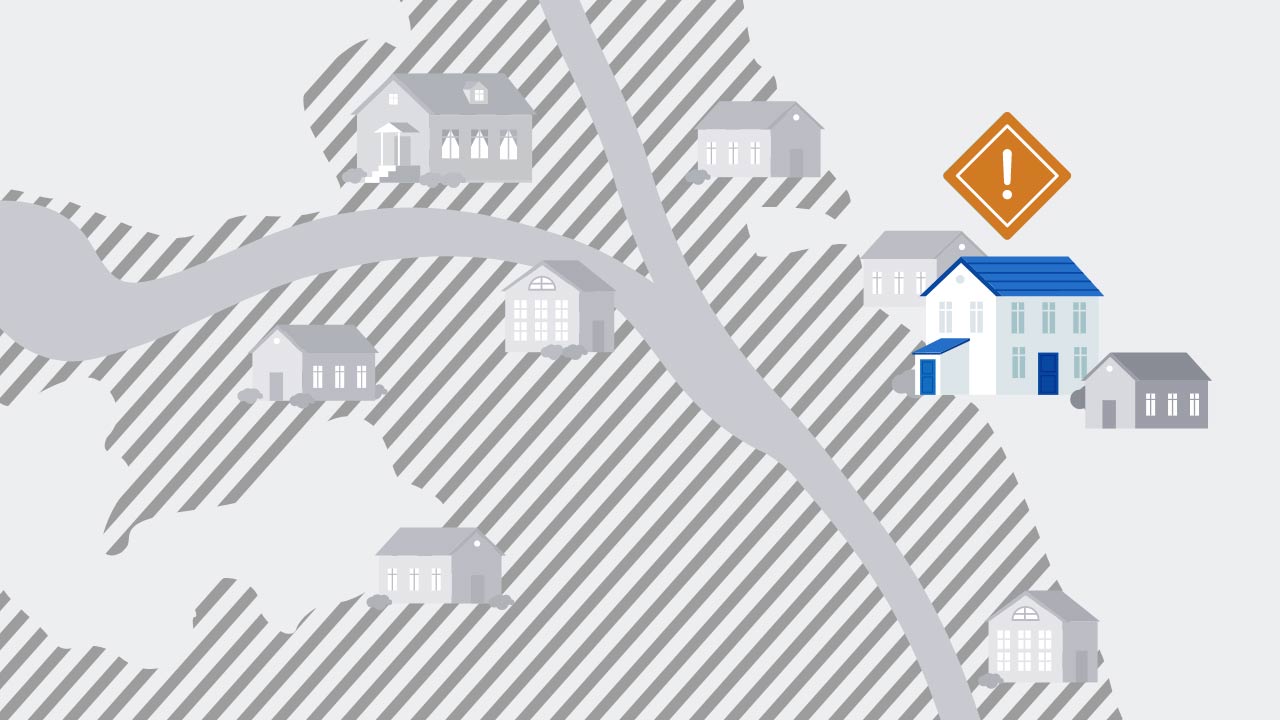How to Use a Flood Zone Map
Find your home’s flood risk level

Determining your location
Since the early 1970s, the Federal Emergency Management Agency (FEMA) has been responsible for creating and updating flood zone maps for communities across the U.S. Over time, these maps have become more detailed and easier to read, helping homeowners verify whether their property is at risk of flooding. They’re also used by government officials and insurance agents to determine flood insurance requirements and policy costs. But what, exactly, does a flood zone map communicate, and how can you check if your home is in a high-risk area?
Understanding flood zone maps
Flood insurance rate maps (FIRM), known more commonly as flood zone maps, provide an overview of geographic regions and their varying levels of flood risks. In most cases, coastal and low-lying areas have the highest chance of flooding, though extreme weather can threaten homes at every elevation. Before looking up your neighborhood, it’s important to understand some of the key terms used in flood zone maps, including:
- Floodplains: Areas of low-lying ground that are adjacent to a river or other body of water, which makes them more prone to seasonal flooding.
- Special flood hazard area: Regions that FEMA has identified as having a high risk of flooding and where flood insurance is mandatory.
- Base flood elevation: The calculated elevation that floodwaters are anticipated to rise to during a base flood event, also referred to as the “1% annual chance flood” or “100-year flood,” according to FEMA.
As suggested by their name, flood zone maps are divided into “zones” that reflect the severity or type of flooding common in a given area. Each zone has its own level of flood risk and different regulations concerning flood insurance. Here’s a quick breakdown of the key flood zones you should look out for:
Moderate- to low-risk areas
- Zone B or X (shaded): Refers to regions with moderate flood hazards and base floodplains that may pose a risk to buildings and public property.
- Zone C or X (unshaded): Areas with minimal flood risks, such as those that have ponding and/or local drainage problems.
High-risk areas
- Zone AE: Regions with a 1% annual chance of flooding and a 26% chance over the life of a 30-year mortgage.
- Zone AH: Areas with a 1% annual chance of shallow flooding, usually due to ponds or other bodies of water with an average depth of 1 to 3 feet.
- Zone AO: River or stream flood hazard areas with a 1% or greater chance of flooding each year, often due to sheet flow.
- Zone AR: Any region that has a temporarily increased flood risk due to the construction or renovation of flood control systems, such as levees or dams.
- Zone V: Coastal areas that have a 1% or higher chance of flooding, along with an increased risk of storm surge.
Many states require homeowners living in high-risk flood zones to purchase insurance through the National Flood Insurance Program (NFIP), while property owners in moderate- to low-risk regions can opt out. However, most insurance experts recommend purchasing some level of flood protection even if you live outside of a high-risk area.
How to check if your home is in a flood zone
The easiest way to access your neighborhood's flood zone map is to visit FEMA’s Flood Map Service Center, which provides a country-wide overview of at-risk areas. The map can help you locate flood zones, floodways and the level of risk your home faces, along with topographical information about local flood control systems like levees, coastal barriers and the base flood line. Since flood risks change over time, the NFIP and FEMA are constantly updating their maps to reflect the most recent data collected.
If you’re having a hard time determining if your home falls into a high-risk flood zone, we can help. Contact a representative today at 844-395-4419 to learn more about flood hazards in your area and the benefits of flood insurance.
Your Policy, Policy Declarations or Amended Declarations in effect on the date of loss is the primary source of reference for your coverage, coverage limits and deductible amounts.
This inclusion of non-Amica companies, products, services or statement herein (“Third-Party Content”) is for general informational purposes only and does not constitute a recommendation or endorsement by Amica Insurance. Policies, views, opinions or positions of Third-Party Content expressed herein are those of the authors and do not necessarily reflect the policies, views, opinions or positions of Amica Insurance. Amica Insurance makes no warranties, expressed or implied, as to the accuracy and reliability of Third-Party Content.
This content may contain helpful tips, explanation and advice. Your use of this information is voluntary and may not be effective in every circumstance. Amica encourages you to use good judgement and put safety first.
For more information on our editorial process and content standard, take a look at our editorial guidelines.